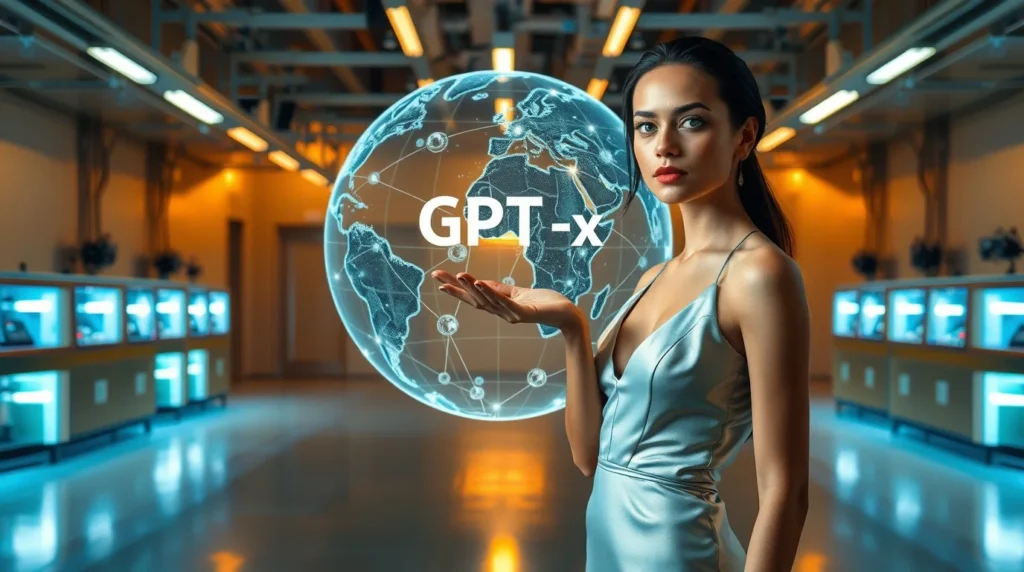Table of Contents
Introduction
The History and Power of ChatGPT: The world of artificial intelligence has witnessed remarkable transformations over the years, and at the forefront of this evolution is ChatGPT. As a groundbreaking model developed by OpenAI, it has reshaped how we interact with technology. From its humble beginnings to becoming an integral part of various industries, ChatGPT’s journey encapsulates the spirit of innovation.
In this post, we’ll explore the history of ChatGPT development—from its origins as GPT-1 to its current iteration—and examine how each version has pushed boundaries in AI capabilities. Join us as we delve into significant milestones, features, and limitations that have defined this powerful conversational agent. Whether you’re a tech enthusiast or curious about AI advancements, there’s much to uncover about what makes ChatGPT so influential today.

The History and Power of ChatGPT
ChatGPT stands as a testament to the rapid advancements in artificial intelligence. Its innovative breakthroughs have transformed how machines understand and generate human language, offering unprecedented interaction quality. The journey began with the development of foundational models like GPT-1.
Each subsequent version has introduced enhancements in architecture and training data, refining performance significantly. From text generation to complex conversational abilities, ChatGPT has proven its versatility across various applications, making it an essential tool for businesses and individuals alike seeking efficient communication solutions.
The Genesis of ChatGPT
ChatGPT began as a project by OpenAI, rooted in the desire to develop advanced natural language processing capabilities. The initial concept emerged from the groundbreaking research on generative pre-trained transformers (GPT), which aimed to create AI models that could understand and generate human-like text. The History and Power of ChatGPT.
The genesis of ChatGPT can be traced back to its first version, GPT-1. This model laid the foundation for future iterations by utilizing unsupervised learning techniques on diverse datasets, paving the way for more sophisticated conversational agents.
What Was GPT-1 and How Did It Start?
GPT-1, launched by OpenAI in June 2018, marked the inception of the Generative Pre-trained Transformer model series. Built on a transformer architecture, it utilized unsupervised learning and was trained on diverse internet text. This foundational model laid the groundwork for future iterations. The History and Power of ChatGPT.
The essence of GPT-1 was its ability to generate coherent text based solely on input prompts. Despite being relatively simple compared to later versions, it showcased significant potential for natural language understanding and generation, captivating researchers worldwide.

How Did GPT-2 Improve on Its Predecessor?
GPT-2 marked a significant upgrade from its predecessor, GPT-1, primarily through increased scale. With 1.5 billion parameters compared to GPT-1’s 117 million, it demonstrated improved understanding and generation of human-like text. This leap allowed for more coherent and contextually relevant responses. The History and Power of ChatGPT.
Additionally, GPT-2 was trained on a diverse dataset scraped from the internet, enhancing its knowledge base and versatility. The model introduced better fine-tuning capabilities that made it adaptable across various applications while addressing some limitations seen in the earlier version.
What Made GPT-3 a Game Changer?
GPT-3 marked a significant leap in AI capabilities with its 175 billion parameters. This sheer scale allowed it to understand context and generate human-like text more effectively than any previous model. Its ability to perform tasks without specific training made it versatile for various applications, from content creation to coding. The History and Power of ChatGPT.
Moreover, GPT-3 introduced few-shot and zero-shot learning techniques, enabling it to complete tasks based on minimal input examples or even none at all. This innovation broadened the horizons of what AI could achieve across different industries.
What Are the Future Plans for GPT Models?
OpenAI aims to enhance GPT models by focusing on ethical AI development and improved user interfaces. Future updates will prioritize reducing biases and increasing contextual understanding, making interactions more natural and relevant.
Additionally, OpenAI plans to expand the application of these models across various industries. This includes refining capabilities for specialized tasks like programming assistance and content generation while ensuring accessibility for all users, paving the way for broader integration into daily workflows.

GPT’s Major Milestones
The journey of ChatGPT is marked by significant milestones that highlight its development. Starting with GPT-1 in 2018, OpenAI introduced the world to a new level of language processing capabilities, laying the groundwork for future advancements.
In 2019, GPT-2 emerged with improved contextual understanding and generation abilities. The model’s release sparked discussions about ethical AI usage. By 2020, GPT-3 took center stage, boasting an astounding 175 billion parameters and revolutionizing how we interact with AI technology across various applications. The History and Power of ChatGPT.
History Of ChatGPT: A Timeline Of Developments
The history of ChatGPT is marked by significant milestones that showcase its evolution. In 2018, OpenAI introduced GPT-1, laying the groundwork for natural language processing advancements. It was followed by GPT-2 in 2019, which improved text generation capabilities and sparked discussions about ethical AI use.
In 2020, GPT-3 emerged as a groundbreaking model with 175 billion parameters, revolutionizing conversational AI. Subsequent developments led to enhanced versions like ChatGPT Plus and further iterations within the series, indicating an ongoing commitment to refinement and innovation in generative AI technology. The History and Power of ChatGPT.
The Future Of ChatGPT And Alternative Generative AI Chatbots
The future of ChatGPT and alternative generative AI chatbots looks promising as advancements in natural language processing continue to rise. Enhanced algorithms will allow these models to understand context better, providing more accurate and personalized responses.
Moreover, as businesses increasingly adopt AI-driven solutions, competition among developers intensifies. This environment fosters innovation, leading to diverse applications across various industries—from customer service to creative writing—that could redefine how we interact with technology. The next era of conversational agents promises exciting possibilities for users worldwide. The History and Power of ChatGPT.

The Wide-Ranging Influence of ChatGPT
ChatGPT’s influence spans numerous sectors, revolutionizing customer service, content creation, and education. Businesses leverage its capabilities to enhance user experiences through personalized interactions and efficient problem-solving, streamlining operations in ways previously thought impossible.
In academia, ChatGPT aids students with research assistance and tutoring. Its ability to generate human-like text has transformed writing processes across various industries. By pushing the boundaries of natural language processing, ChatGPT continues to shape communication methods while inspiring future innovations in AI technology. The History and Power of ChatGPT.
Features and limitations of ChatGPT
ChatGPT boasts impressive features, including natural language understanding, context awareness, and the ability to generate human-like responses. Its versatility allows it to assist in various applications such as customer support, content creation, and educational tools. Users appreciate its capacity for engaging conversations and providing detailed information on a wide range of topics.
However, ChatGPT has limitations. It may sometimes produce incorrect or nonsensical answers due to biases in training data or lack of real-time knowledge updates. Additionally, it can struggle with highly specific queries or nuanced subjects requiring expert insights. The History and Power of ChatGPT.
Applications and Service Overview
ChatGPT has become a versatile tool, finding applications across various sectors. Businesses leverage it for customer support, automating responses to common inquiries and enhancing user experience. Educators utilize ChatGPT to provide personalized tutoring and assist with academic writing.
Additionally, content creators rely on its capabilities to generate ideas and drafts effortlessly. Developers integrate ChatGPT into apps, enabling interactive storytelling or brainstorming sessions. Its flexibility allows organizations to innovate while improving efficiency in communication and information processing tasks. The History and Power of ChatGPT.

ChatGPT: A New Chapter in AI’s Story
ChatGPT represents a transformative milestone in the narrative of artificial intelligence. With its ability to understand and generate human-like text, it has redefined how we interact with technology. Its conversational capabilities enable seamless communication across various platforms.
The impact extends beyond casual user interactions; businesses are leveraging ChatGPT for customer service, content creation, and more. This evolution showcases not just technological advancement but also a shift in AI’s role within society—empowering individuals and organizations alike through innovative applications. The History and Power of ChatGPT.
Evolution of AI: From GPT-1 to GPT-4o – Key Features, Milestones, and Applications
The evolution of AI from GPT-1 to GPT-4o showcases remarkable advancements in natural language processing. Initially, GPT-1 laid the groundwork with simple text generation capabilities. Each iteration introduced enhanced architecture and larger datasets, allowing models to understand context better and generate more coherent responses. The History and Power of ChatGPT.
GPT-3 was pivotal, boasting 175 billion parameters that revolutionized conversational AI. Now with GPT-4o, improvements include greater contextual awareness and refined responses across diverse applications such as content creation, customer support, and educational tools. This evolutionary path reflects a significant leap in AI technology’s potential impact on various industries.

How Has the Efficiency of AI Models Improved Over Time?
The efficiency of AI models has significantly improved over the years through advancements in architecture and training techniques. Early models, like GPT-1, were limited by their size and data quality. Innovations such as transfer learning and unsupervised pre-training led to more effective use of computational resources. The History and Power of ChatGPT.
Moreover, optimized algorithms have reduced training time while increasing model accuracy. With each iteration—from GPT-1 to GPT-3—OpenAI refined its methods, allowing for larger datasets and deeper networks that enhance performance across various applications.
Industries that Can Benefit from GPT-4o
Various industries stand to gain significantly from GPT-4o’s advanced capabilities. In healthcare, the model can assist with patient interactions, medical documentation, and even diagnostic suggestions. Its ability to process vast amounts of data rapidly aids in research and personalized medicine.
Similarly, the education sector can leverage GPT-4o for creating tailored learning experiences. It enables real-time tutoring and content generation while supporting teachers in lesson planning. Businesses across finance and marketing also benefit through enhanced customer service automation and predictive analytics. The History and Power of ChatGPT.

Conclusion: The journey of ChatGPT
The journey of ChatGPT from its inception to the latest iterations reflects a remarkable evolution in AI technology. Each version has brought significant advancements, enhancing capabilities and applications across various industries. As we continue to witness breakthroughs in natural language processing, tools like ChatGPT will undoubtedly play a crucial role in shaping how humans interact with machines.
With ongoing developments and improvements on the horizon, the future looks bright for generative AI chatbots. The history of ChatGPT development showcases not only technological progress but also an expanding influence that can transform communication, education, and business practices globally. Embracing these innovations will open new avenues for creativity and efficiency as society navigates an increasingly digital world. The History and Power of ChatGPT.
Frequently Asked Questions (FAQs) About The History and Power of ChatGPT
What is ChatGPT?
ChatGPT is a conversational AI model developed by OpenAI based on the “Generative Pre‑trained Transformer” (GPT) architecture. It can understand prompts in natural language and generate coherent, contextually relevant responses. The History and Power of ChatGPT.
Who created ChatGPT?
ChatGPT was created by OpenAI, an AI research organization founded in 2015 by Elon Musk, Sam Altman, and others with the mission to ensure artificial general intelligence benefits all of humanity. The History and Power of ChatGPT.
When did ChatGPT first appear?
The first GPT model (GPT‑1) was released in June 2018, paving the way for subsequent versions that evolved into today’s ChatGPT conversational agent. The History and Power of ChatGPT.
What was GPT‑1?
GPT‑1 was the inaugural transformer‑based language model, trained on unsupervised internet text. With 117 million parameters, it demonstrated the potential for generative text tasks. The History and Power of ChatGPT.
How did GPT‑2 improve over GPT‑1?
GPT‑2 (February 2019) scaled up to 1.5 billion parameters, trained on a much larger web‑scraped dataset—yielding more fluent, context‑aware text and sparking conversations about AI safety. The History and Power of ChatGPT.

Why was GPT‑3 a game changer?
Launched in June 2020 with 175 billion parameters, GPT‑3 dramatically improved language understanding and generation, enabling few‑shot and zero‑shot learning across diverse tasks without fine‑tuning. The History and Power of ChatGPT.
What is few‑shot and zero‑shot learning?
Few‑shot learning lets GPT‑3 perform tasks given just a handful of examples; zero‑shot lets it generalize to new tasks from only the task description, without any examples. The History and Power of ChatGPT.
When did “ChatGPT” as a branded product launch?
OpenAI launched the interactive ChatGPT web interface in November 2022, optimized for conversational use and fine‑tuned for dialogue. The History and Power of ChatGPT.
What is GPT‑4 (and GPT‑4o)?
GPT‑4, released in March 2023, further expanded model scale and multi‑modal abilities (text + images). GPT‑4o (“omni”) adds support for audio and vision inputs. The History and Power of ChatGPT.
How does ChatGPT understand context?
It processes input sequence tokens via a transformer with self‑attention layers, allowing it to weigh and remember relevant context over hundreds of tokens. The History and Power of ChatGPT.

What is a ChatGPT pentest and why is it important?
A ChatGPT penetration test evaluates the security of your GPT integration—testing for prompt‑injection, data leakage, API abuse, and improper access controls. It helps safeguard sensitive data and maintain compliance with privacy policies.
How do I create an online course with ChatGPT?
Use ChatGPT to outline your curriculum, generate lesson scripts, create quizzes and assignments, draft slide copy, and suggest multimedia ideas. You can also have it produce promotional materials and email drip sequences for course launch.
What services does a ChatGPT development company offer?
Such companies provide custom model fine‑tuning, API integration, UI/UX design for chat interfaces, data‑pipeline setup, compliance consulting (e.g., GDPR, HIPAA), ongoing maintenance, and performance monitoring.
How do I use a ChatGPT vector database?
Store your documents’ embeddings in a vector database (Pinecone, Weaviate, etc.). At query time, embed a user’s question with ChatGPT’s encoder, retrieve nearest neighbors via similarity search, then augment prompts with those context snippets for more accurate answers.
Can I use ChatGPT for drafting and managing contracts?
Yes—ChatGPT can draft standard contract templates, suggest clause modifications, track version changes, and generate summaries of each iteration. Integrate it into your document‑management system for collaborative editing and audit trails.

How does ChatGPT coding work?
ChatGPT coding uses GPT models to generate, explain, and debug code across languages. By providing prompts, users receive function implementations, code snippets, and optimization suggestions. It accelerates development, automates repetitive tasks, and aids learning. Integration via API enables embedding coding assistance into editors, CI pipelines, and educational platforms robustly.
What is OpenAI Codex?
OpenAI Codex is a descendant of GPT-3 trained specifically for code generation. It interprets natural language prompts to create functions, scripts, and applications in multiple programming languages. Developers integrate it via API to automate coding tasks, prototype software, and build intelligent coding assistants that understand context and intent precisely, seamlessly.
How does Codex pricing work?
Codex pricing follows OpenAI’s tiered API model, charging per token processed. Free trial credits apply initially. Paid tiers bill based on usage volume and model complexity, with lower rates for smaller models. Enterprise agreements offer customized pricing, higher rate limits, and dedicated support for large-scale deployments requiring consistent cost predictability.
What are ChatGPT pricing options?
ChatGPT pricing varies by plan. The free tier offers limited usage and standard response speeds. ChatGPT Plus costs $20 per month, unlocking faster responses and priority access. Team and enterprise plans offer centralized billing, enhanced security, and usage analytics; pricing depends on seat count and consumption for scalable enterprise‑grade services.
What is Cursor?
Cursor is an AI-powered code assistant that integrates with editors to provide real-time code completion, documentation lookup, and refactoring suggestions. It uses machine learning to predict relevant snippets, navigate codebases, and automate routine tasks. Developers benefit from accelerated workflows, reduced errors, and context-aware coding support across projects collaboratively, efficiently, effectively.

4 thoughts on “Innovative Breakthroughs: The History and Power of ChatGPT 2025💡”